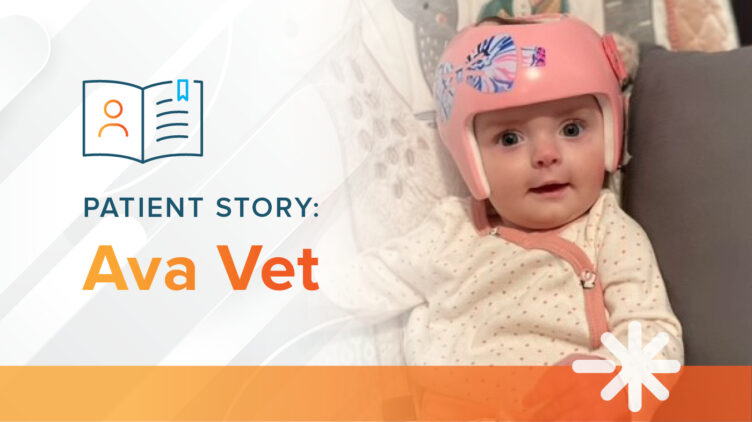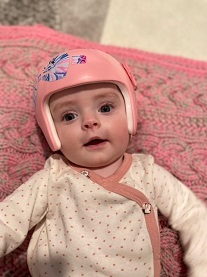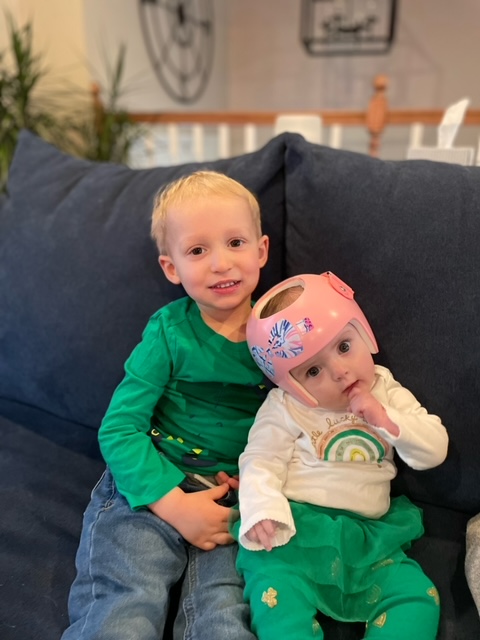Plagiocephaly and Torticollis: Why Ava Wears a Helmet

At just 1-month old, Leneé Vet noticed a flat spot on the back of baby Ava’s head. Shortly thereafter, she was diagnosed with plagiocephaly and torticollis. With the help of a cranial helmet and her care team, Ava’s head is gradually growing into a more symmetrical shape.
When Ava was 1-month old, Leneé noticed a flat spot on the back side of her head. She mentioned her concerns to her pediatrician at Ava’s 2-month appointment. They referred Ava to physical therapy. It was there that Ava was diagnosed with plagiocephaly and torticollis. “Initially, I felt guilty, as if I did something wrong as a parent. I knew of plagiocephaly, but never heard of torticollis. I didn’t know the two were related. I started to research everything I could to learn more, from talking with my pediatrician and physical therapists to searching the internet and joining social media groups.”
Plagiocephaly, sometime referred to as “flat head syndrome”, is becoming increasingly more common due to widespread efforts to reduce the incidence of Sudden Infant Death Syndrome (SIDS) which encourages parents to place their babies on their backs to sleep. If your baby has an asymmetrical head or flat spot on the back or side of their head, it’s always good to talk to your pediatrician about your concerns.
Katie Toth, MPO, CPO
After a month of physical therapy, Ava’s flat spot was worsening despite stretches and repositioning. Just before Ava was 4-months old, her physical therapist recommended she schedule a free evaluation at Hanger Clinic in Albany, New York for a cranial remolding orthosis.
Being Fitted for a Cranial Helmet
Ava started with an initial consultation and measurement and was placed in the severe range for plagiocephaly. She then had an appointment with a neurosurgeon who confirmed her plagiocephaly and torticollis diagnosis and prescribed a cranial helmet. A week later, she had her second appointment at Hanger Clinic, where she was scanned and measured for her helmet.
What is a Cranial Helmet?
A corrective helmet, also known as a cranial remolding orthosis, acts as a mold for the infant’s head, restricting further asymmetric growth and guiding the flattened areas to grow into the empty space of the helmet in a normal, rounded fashion.

“We have received excellent care from Hanger Clinic. Katie Toth has been so great in helping us through Ava’s journey, and responds to any concerns we have, even after hours and on weekends. She has guided us on what to do and addresses all our questions.”
When Ava was 5-months old, she received her cranial helmet, and it didn’t take long for her to get used to wearing it.
“It took us a few days to get into a routine, being comfortable taking it on and off, washing Ava’s head and the helmet. In the first week, we worked toward wearing it for longer periods of time. There were times when Ava appeared uncomfortable. During those times, we would give her a break, wash her head and the helmet, and she would be good when we put the helmet back on again. After about 6 days, our routine was established, and it became easier as Ava wore the helmet for longer periods of time.

I really appreciate the team at Hanger Clinic and would recommend them to other families. They are well trained and knowledgeable. We have confidence that Ava is being well cared for and that we are doing what is best for her.”
Leneé’s Advice for Parents
“Always speak up and be an advocate for your baby, and trust your instinct if something does not seem right. If you find out that your child needs additional support, take it one day at a time and don’t be afraid to ask questions. There are good days and frustrating days. The cranial helmet seems harder on us as parents than on our baby. Progress with torticollis has been slow, but the helmet is making a huge difference in Ava’s head shape.”
Plagiocephaly
Plagiocephaly, or “flat-head syndrome,” is a relatively common condition characterized by a flat spot on the back or side of a baby’s head. Plagiocephaly can be caused when the baby’s head frequently rests in the same position on everyday surfaces such as a mattress or car seat, or it can even happen in the womb. It can develop in as little as one week and is present to some degree in nearly half of infants.
Torticollis
Torticollis is a tightening of the muscles on one side of the neck, which often results in a child’s head tilting towards one shoulder and their chin rotating to the opposite side. This can occur based on how the baby is positioned in the mother’s uterus.
What Parents Need to Know About Flat Head Syndrome
Interested in learning more? We sat down with cranial specialist Katie Toth, MPO, CPO to answer some of the most common questions about “flat head syndrome” and how to treat it. Discover answers to your questions.
Find a Cranial Specialist
With over 200 specialists at more than 260 locations nationwide, Hanger Clinic’s network of Cranial Asymmetry Remolding Experts (CARE Network) helps ensure patients and families receive access to unparalleled care and expertise.
Latest Updates
Subscribe to stay up-to-date on our latest posts.


